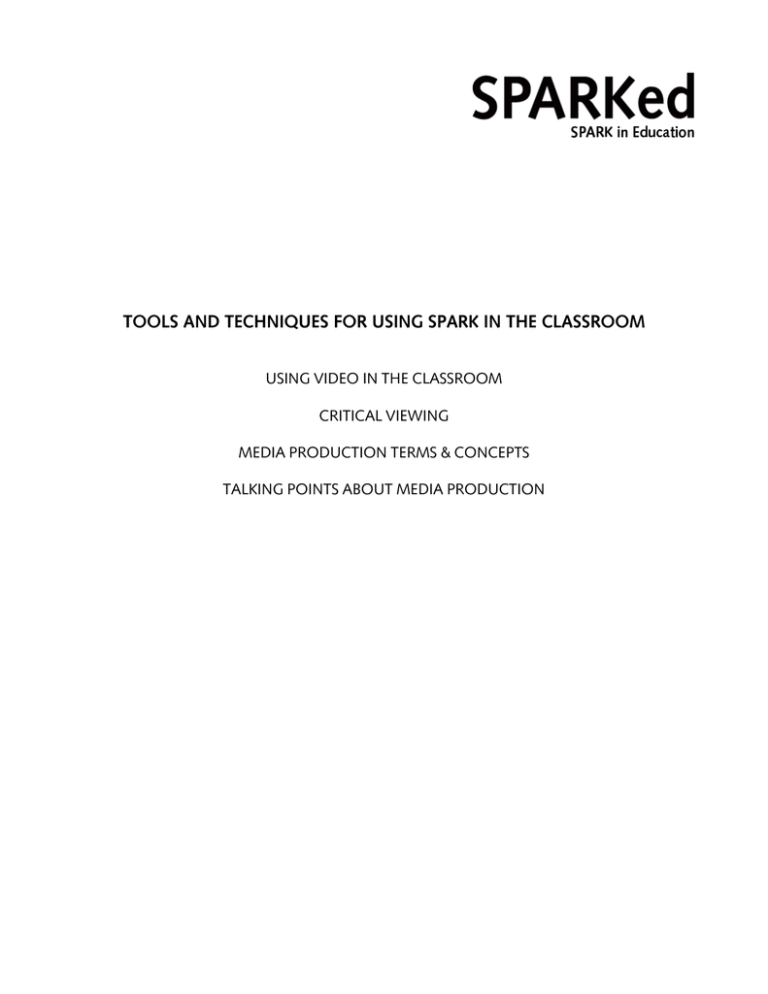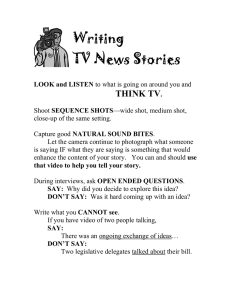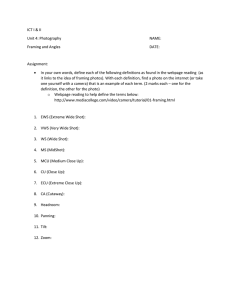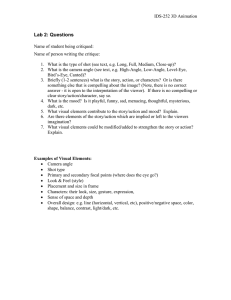tools and techniques for using spark in the classroom
advertisement

TOOLS AND TECHNIQUES FOR USING SPARK IN THE CLASSROOM USING VIDEO IN THE CLASSROOM CRITICAL VIEWING MEDIA PRODUCTION TERMS & CONCEPTS TALKING POINTS ABOUT MEDIA PRODUCTION Why Use Video in the Classroom? Teachers use video for a variety of reasons. Video can breathe meaning and life into nearly any lesson. In the arts, video can be particularly effective for introducing large concepts in the arts, aspects of the creative process, and key arts-related vocabulary to introduce students to discipline-based, and concept-based study. Using video, a teacher can: • • • • • • • • • Provide a common experience for all students. Generate interest and stimulate imagination. Offer a different perspective on or another approach to a topic. Connect students with faraway place. Demonstrate abstract ideas. Stimulate the development of critical thinking skills. Equalize educational opportunities. Enhance self-respect and break down social stereotypes. Promote critical viewing skills and media awareness. Hot Tips Explore new sources for educational videos with your media librarian, local PBS station and cable television service. Re-purposed powerful segments of a video-one video clip can contribute to many different lessons. Become familiar with the features of your television and VCR, especially the Record and Memory functions. Delegate the job of operating the VCR to responsible students. Ask students, parents and volunteers to help record, label and cue videotapes. Be sure television carts are moved only by adults. Collaborate with other educators to screen programs, share ideas and plan video-related activities. Integrate video planning with other curriculum and technology planning activities. Using Video Effectively Video can be a powerful tool for meaningful learning. It all depends on you. The key to using video effectively is preparation. Maximize learning opportunities by encouraging students to become active viewers. Before Viewing • Preview the video for appropriate content. • Review related print and Web materials, especially the teacher's guide that may accompany the video series. • Determine whether you will use the entire video or only relevant segments to illustrate objectives in your curriculum. Remember: There is no rule that requires you to use an entire program-even a few seconds of video can be very powerful. • Prepare the classroom environment and video equipment. Choose lighting to enhance the learning experience. Low light increases the dramatic effect while brighter light may be helpful in eliminating distractions. Position yourself to maximize your "facilitator" role. Close proximity to the television monitor makes it easier to point to the screen and explain unfamiliar information. Or you may prefer to move freely among students and control the video image with the remote. 1 SPARK – Video in the Classroom • Stimulate students’ pre-existing knowledge. Have students write down what they are sure they know about the subject and what they think they know. After viewing the video, have students revise their lists based on what they have learned. Divide students into small groups. Have each group summarize what they know about the subject and identify questions they may have. After viewing the video have the groups answer questions, discuss new information and formulate new questions. During Viewing • Give students a focused viewing assignment. Focused viewing questions can make viewing more meaningful by encouraging active viewing and evaluation of content. Give students a task, something they are responsible for remembering or writing down, such as interesting facts or personal responses. • Show one short segment or story at a time and direct the learning experience. Focus clearly on a defined objective. - • A short segment can be shown at the beginning, middle or end of a lesson. Control the pace of the viewing experience and the amount of information. Classify, analyze and discuss each segment thoroughly. Increase observation and listening skills through repeated viewing of the same segment (just as you would review printed source material). Encourage student awareness of production values and techniques. Have students watch for elements of the production, such as camera angles, shot choices, and music. ? ? What effects do these techniques have on the delivery of the content? How does the director manipulate the viewers' reactions? • Press “Pause” often. Take time to identify and clarify what the students are watching. Stop to hypothesize and predict answers whenever a question is asked. Clarify new vocabulary as it is used. Let students ask for a PAUSE to allow for immediate feedback to their personal interests and comments. • Try viewing without the sound. Provide your own video commentary and eliminate any narration that may be inappropriate for your students. Identify students' prior knowledge or assess what they have learned by having them provide their own narration. Encourage students to share their own questions as they view without sound. Then view the program with sound to discover whether these questions have been answered. • Use video without the picture. Cover the screen with paper or turn it around. Have students listen and gather ideas before viewing. What roles do the music, visuals and narration play? After listening to a video, have students create their own visual images and compare them with the video images. • Try a second viewing. For younger students especially, the first viewing may elicit emotional responses. A second viewing vies them a chance to view more objectively. Use a second viewing to focus on additional curriculum content. • Try closed-captioning. Use closed captions as a reading reinforcement with or without the sound. Closed captions are effective to use with English-language learners. After Viewing - Ideas for Younger Students Turn to Your Neighbor After viewing a video program, have students “turn to their neighbor” and ask them to explain something about the program. Learning Event While viewing, have students record the interesting fact(s) they learned from the story. Afterwards, host a “learning 2 SPARK – Video in the Classroom event” during which students walk around the room, greet each other, and exchange their interesting facts. Younger students can be provided with a "Did you know ____________?" form to complete by drawing a picture or noting a key word. Although each student is responsible for only one fact, he or she will be reminded of many additional facts in this process. Following the activity, the facts can be categorized and organized for further study. Quick Write In a personal journal or on paper, have students write quickly for two minutes to record any thought that comes to mind after viewing a program or segment. This activity is especially effective to record personal thoughts following emotionally stimulating programs. Four Corners Choose four main concepts or topics in the video and label each corner of the room with one of the concepts. For example, if exploring poetry, the corners might be Metaphor, Reading, Vocabulary, and Personal Expression. Ask the students to choose a corner of the room that matches the concept they wish to explore. Plan an activity for the students in each corner and have them share their findings with the class. This technique can be very effective for initiating class discussions on different concepts in one segment. Show, Not Tell After watching a highly visual video, such as a segment on glassblowing, ask students to write a paragraph called "The Glass Was Hot," emphasizing the use of descriptive words and metaphors while avoiding the use of the words garbage or gross. Think-Pair-Share After asking a follow-up question to a video program, have students pair with a neighbor to discuss their responses. Invite students to share their responses with the whole group. Roundtable/Round-Robin After viewing a video program, ask a follow-up question that has several possible responses. To have a roundtable, have students make a list of possible responses on one piece of paper circulated among them. To have a round robin, share responses orally. After Viewing - Ideas for Older Students Brainstorm Present a key vocabulary word or concept from the video, such as alliteration. Ask students to form small groups to generate related concepts, such as rhyming, metaphor, onomatopoeia, or hip-hop/rap. Select one student in each group to record the ideas and present a summary of the responses to the entire class. Allow students to question their classmates about particular ideas they have generated. After each group has reported, summarize the ideas of the entire class and provide additional information or clarification as needed. Categorize/Clarify Divide students into groups to develop a conceptual word map. Begin by having students write a key word or concept from the video in the center of a blank “map” on chart paper or an overhead transparency. Have each group build the map by adding words related to the key word and arranging them in categories. Discuss each diagram and supply additional information to extend students' understanding of the topic. Compare and Contrast To encourage students to compare and contrast ideas, divide them into groups to make Similarities/Differences Charts. After presenting two ideas, have each group discuss similarities and record them on chart paper. Then have students discuss and record differences. Have students present their charts. Discuss each diagram and supply additional information to extend their understanding of the topic. If necessary, review the video to add to the lists. Numbered Heads Together Divide students into groups of four, assigning each student a number (from 1 to 4). After asking a follow-up question to a video program, have students “put their heads together” to assure that everyone in the group understands the 3 SPARK – Video in the Classroom answer. Call a number (1 through 4) and have the students with that number respond to the question. Jigsaw Divide students into groups of four, assigning each student a number (from 1 to 4). While watching a video program, assign each group member a different concept to understand or a question to answer. For example, in a program about classical music from North India, students in Group #1 might explore how music in North India is integrated into the culture, while the #2 students might consider the question of gharanas (lineage houses of music in India). After viewing the program, have each group member teach what he or she has learned to the other members of the group. Have each student quiz the group members until everyone understands how the pieces of the “puzzle” fit together to make one “picture.” Problem Solvers Describe a problem that can be solved from the content in a video segment - for example, how to make glass. After viewing the video, have groups of students determine the solution. Each group may decide how to approach the problem, but the approach must involve all members. Alternatively, they may solve the problem together, but each student must be able to explain the solution. 4 SPARK – Video in the Classroom CRITICAL VIEWING 1 Watch the SPARK segment, noting down key ideas, thoughts and responses. 2 Mute the sound and watch a part of the story that focuses on a single artwork. Freeze the video or DVD on that piece and respond to the following questions Describe the artwork in as much detail as you can What interests you in this piece? In what ways is it unique? How does the artwork function intellectually, emotionally, and/or psychologically? What ideas or associations does the work inspire? What, in your view, was the artist’s purpose or intention? 3 Working in pairs, share your responses and consider the ways in which your ideas are the same or different. 4 As a group, explore why members of the group respond differently to a work of art. What accounts for these differences? What factors shape how we see and respond to art? 5 As a group, discuss the notion of “good” and “bad” in relation to the perceived value art. What determines art as “good” or “bad”? Who determines these values? What role(s) do these determinations play in how we see and respond to art? 6 Move on to discuss the following factors and how they affect our individual responses: Knowledge – knowledge of art, artist, art form, or particular artwork content Experience – experience seeing and/or interacting with art and artists Culture – cultural background, attitudes, assumptions, and difference(s) Gender – relationship to particular art, artist, or artwork content Age – relationship to particular art, artist, or artwork content Context – environment, place and time in which the work(s) were experienced Class - – relationship to particular art, artist, or artwork content 7 Write 500 words on: Viewing artwork: the factors that determine “taste” MEDIA PRODUCTION CONCEPTS, TECHNIQUES AND TOOLS USED IN PRODUCING NARRATIVE MEDIA NARRATIVE A narrative is a plot or storyline. In a piece of media, a narrative is the coherent sequencing of events across time and space. Dramatic action in a narrative usually involves key turning points, and moments of tension that are resolved at the end – i.e. the story has a beginning, middle, and an end. Most films produced at large, commercial studios follow a formulaic narrative arc, starting with contentment and then moving through disruption, identification of a problem, pursuit of a solution, struggle, resolution and then back to contentment. POINT OF VIEW The opinion or perspective expressed. This can be the perspective of the producer – the person who researched and produced the story - as expressed through the narrator or through the viewpoint(s) of the characters. Point of view can also be expressed though the eyes of a first person narrator telling his or her own story. SHOT A shot is a single sequence of a film, video or television program taken by one camera without interruption. A shot can be of an artist working in a studio, or of a symphony orchestra playing. A story is comprised of many shots, one after another, that have been edited together. Celluloid footage (actual film) is physically spliced together – that is, two ends of film are melded together. In digital video, shots are sequenced on a computer by lining up the end of one shot and the beginning of another, although it is still called a “splice.” SHOT TYPES Different types of shots produce different effects, determined by the camera’s proximity to the main subject. Establishing Shot – A long shot used at the beginning of a sequence to establish a setting or scene Close-Up – A shot taken very close to the subject (head, neck and shoulders) so that it fills most of the frame Big Close-Up – A shot in which a person’s face fills up most of the frame Medium Close-Up – A shot framing a person from the level of mid-chest Full Shot – A shot in which a person’s complete body is included, usually equal to the height of the frame Long Shot – A shot in which a person’s complete body is included but is at a distance from the camera Extreme Long Shot – A shot in which a person’s size is very small in comparison to the screen CAMERA ANGLES A producer or director will also use camera angles to achieve different effects. Straight On/Eye Level The camera is located at the eye level of the subject(s) High Angle/Angle Down The camera is positioned above the subject Low Angle/Angle Up The camera is positioned below the subject. Dutch Angle The camera is tilted so that the frame is not parallel to the horizon. 1 SPARK – Video Production: Terms & Concepts OPTICAL DEVICES Optical devices are used to exaggerate transitions for particular effect. Fade-In Fade-Out Iris-In Dissolve Wipe A shot that begins in darkness and gradually brightens. A shot that begins in brightness and gradually fades to black. A shot beginning in darkness and gradually getting lighter in a circle Superimposition of the end of one shot onto the beginning of another so that the two images overlap for a period of time. A vertical line seems to wipe across the screen, wiping out one scene and wiping in the next. CAMERA LENS By adjusting the lens, a camera can alter the perceived magnification, depth of field, perspective and scale of subjects and objects in a shot. Normal Produces an image with normal perspective, akin to looking with the naked eye. Wide-Angle Produces a field of view that is wider than the human eye can apprehend, exaggerating the distance between foreground and background. In a wide-angle shot, objects or subjects moving towards the camera appear to do so very rapidly. Telephoto Enlarges or magnifies distant planes, making them appear closer to those in the foreground, such as with foreshortening. In a telephoto shot, objects or subjects moving towards the camera appear to take quite a long time. Zoom A lens that can be adjusted during a shot to many foci, including normal, telephoto and wide angle. Deep A shot in which all objects and subjects are seen close up in the foreground in sharp focus. Soft Focus A shot in which the foreground is in sharp focus and the background appears out of focus or unclear. This effect can also be affected by taking the shot out of focus, or by putting gauze or other object in front of the camera. CAMERA MOVEMENT How a camera moves when taking a shot. Panorama (Pan) Shot Swish Pan Tilt Traveling Shot Crane LIGHTING Three-Point Lighting The camera rotates from one position on a horizontal plane, (i.e. “pan right,” “pan left”). The camera takes a very fast panorama that blurs the action. The camera rotates vertically from a single position. The camera is mounted to an apparatus, such as a car, track, etc. that moves it is filming. The camera is mounted to a long boom made just for this purpose. Lighting that is projected from three different sources: a key light (a bright, primary light source that casts shadows); a fill light (light that eliminates or softens the shadows made by the key light); and a backlight (lights positioned behind the subjects or objects that outline or highlight their contours). High-Key Lighting Bright, even light with low contrast and few visible shadows. Low-Key Lighting Low level light with high contrast areas of light, such as in Film Noir and horror films. Directional Lighting Use of all other sources, such as overhead, under-lighting, backlighting, etc. 2 SPARK – Video Production: Terms & Concepts TRANSITIONS A transition refers to the relationship between a shot and the one that immediately preceded and followed it. Most of the time, a producer aims for continuity, a form of editing by which the action between shots is smooth and continuous. Continuity is often created by making match cuts or “matches” so that a viewer does not lose their orientation to the space, place, or person(s). Art or experimental filmmakers often intentionally disregard continuity so as to affect a broader range of visual and emotional effects. Movement Match A movement of a subject begun in one shot is or appears to be seamlessly continued or completed in the next shot with the result that the viewer does not notice the cut. Direction Match The direction in which a subject or object is moving is consistent across the splice. Eye-line Match When one subject’s eyes in one shot appear to meet with those of another subject in the next shot. Reverse Shot Alternating shots of two or more different subjects in conversation. In continuity, the eyeline match in a reverse shot is critical to making the scene seamless. Axis Match When the camera angle is kept the same from shot to shot, sustaining a singular point of view or perspective. Position Match When the position of an object or person remains in the same are of the frame from shot to shot. Graphic Match The juxtaposition of graphically similar images, such as the start of a marathon and a car speeding away. Rhythmic Match The juxtaposition of images with actions moving at similar rates or speeds. Jump Cut When the rules of continuity are disregarded; sometimes used to call attention to the medium (film, television, or video). 3 SPARK – Video Production: Terms & Concepts TALKING POINTS ABOUT TELEVISION AND VIDEO PRODUCTION Guiding questions ~ • What do you think is the purpose of this segment? • Who is the intended audience? • How does the production of the media (camera work, music, narration, etc.) support your hypothesis? Watch the segment and note the following 1. What is your general response to the filming of the segment: • Do you find it interesting? Why? • What reactions, ideas, or emotions did it stimulate? • What do you think is the intent of the program (persuasive, informative, etc.)? After you have identified what you think the purpose is, watch the segment a second time and look for the following: 2. Vocabulary/Narration~ • What words/vocabulary is that support the purpose? • What kind of language is used? • What works are used to create or heighten the tone of the piece? • What devices are used to attract our attention, convince or inspire us? 3. Camera Work~ • Does the camera work (the way scenes are shot) support the purpose? • How does the camera work involve you in the piece? • What features of the camera work contribute to the feeling of the piece? 4. Music and/or Sound~ • Describe the music. Is the music in a specific style that supports the purpose? • How does the music contribute to the feeling of the piece? • Is the music or sound important in the piece? Why or why not? 5. Other Components~ • What role does lighting or color play in the piece? • What individuals are shown in the segment? Does the choice of people present support the purpose of the story? How? • Who is speaking (and who is not) in the piece? What effect does the narration have? Write a 500 word summary of the technical aspects of production that impact media “messages.”



